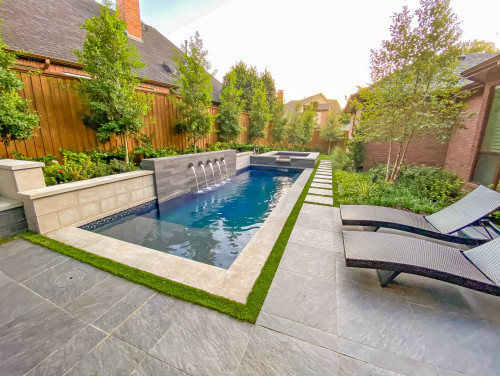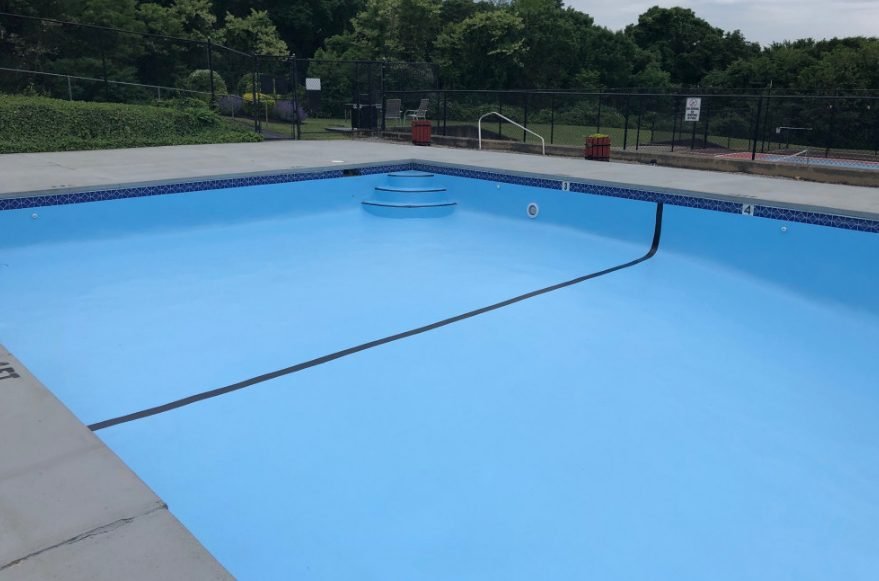Of course, there is no way around that, but there are things you can do to conserve the amount of water that is used by your pool. A properly managed pool or spa can be an appropriate use of water.

Photo by DDLA Design Landscape Architecture – Look for pool design inspiration
If you want to save money, energy and water there are several ways you can practice water conservation with your pool or spa.
1 – Wind Protection
Wind exposure can increase evaporation in uncovered pools. A solution would be planting trees and shrubs that buffer your pool, but won’t shed or drop leaves in the water.
2 – Use a Pool Cover
Using a swimming pool cover regularly reduces evaporation by 90 to 95%. Without a swimming pool cover, more than half the water in your pool can possibly evaporate in one year.
Other benefits of a pool cover:
- A pool cover can be enhanced safety
- A pool cover can reduce the need to use more chemicals.
- Pool covers help to reduce algae growth.
- Pool covers help conserve heat, which can save money for electricity.
You can cover a pool without being concerned about gaseous exchange, unless you are using chlorine gas. If you are using chlorine gas, you should let it air.
3 – Swimming pool pump
A pool filter pump can be one of the largest users of electrical energy in a home. If you reduce the amount of time you run the pump, you’ll save energy and money.
However, the amount of time you’ll have to run your pool filter will vary according to the size of the pool, how much it’s used, and factors such as leaves or dirt that can blow into the water.
Run the pump only as long as needed. A pump should be able to circulate pool water at least every 24 hours, but every 8 hours is preferred. Start by running the pump for eight hours per day. If the pool stays clear, run the pump less often. If it starts to get cloudy, run it a bit more each day until it clears.
4 – Use a Time Clock
An automatic time clock for your filter and cleaning system is one of the smartest investments you can make. With it, you can avoid the electric power “rush” hour by not running your pool or spa filter on hot summer afternoons when demand for electricity is at its highest.
More directly, if you’re buying electricity at a time-of-use rate, avoiding electricity use during peak hours can lower your electric bill. So, once you determine the number of hours required for one complete filtering cycle of your pool water, set your filter prompt time clock for that much time, during off-peak hours.
5 – Pool Filters
Backwashing filters use extra water. Keep the pool and filters clean to reduce the frequency of backwashing. Take the time also, to hand clean the filter and conserve your water for the pool.
6 – Fountains & Waterfalls
When aeration occurs, a significant amount of water can be lost to evaporation. Only run pool fountains and waterfalls when you’re entertaining.
7 – Pool or Spa Draining
If a pool has been properly maintained, it may not have to be drained completely or as frequently. Many experts believe a pool should only be drained every 3-7 years Spas, however, should be drained every three months, depending on how often it’s used.
8 – Water Lower levels
Keep the levels of water in little lower. This uses less water and also decreases the amount of water that will be splashed out of the pool by swimmers and the wind.
9 – Heat Pool Conservatively
If your pool is heated, lower the temperature during the summer. Warmer water means higher evaporation rates, not to mention the waste of energy.
You may want to consider solar heating for your pool. A solar unit, used in conjunction with a back-up heating system, can save on heating costs.
10 – Reuse of water
Reuse backwash or de-chlorinated waste pool water on lawns & shrubs. Empty the filter backwash onto lawns and shrubs or collect it to reuse.
11 – Sanitizer
Add sanitizer in the evening because the sun quickens the dissipation of chlorine, making the evening the best time to add sanitizer to your pool.
12 – Saving Water Saves Energy
Ways to use less water in your pool:
- Ask swimmers to reduce splashing.
- Channel splashed-out pool water into landscaping.
- Lower pool water to reduce amount of water splashed out.
- Plug the overflow line when the pool is not in use.
- Use a broom, not a hose, when you are cleaning around the pool.
13– Leaks
If you suspect your pool is leaking, there are several reliable ways to check. Try one of these approaches:
1/ Use a grease pencil to mark the water level of the pool at the skimmer. Check the mark 24 hours later. Your pool should lose no more than 1/4 inch per day. Otherwise, a leak is indicated.
2/ If you see bubbles in the return water when the pool’s pump is running, it’s likely there’s a leak in the suction side of the filtration system.
3/ This four-step bucket test may help you determine if you have a leak or a high evaporation rate.
- Turn off the automatic fill valve.
- Place a bucket on a step where the bucket rim is at least a few inches above the water line.
- Place a heavy weight in the bucket and add water until the water level inside the bucket is equal with the water level in the pool.
- Leave the bucket and pool undistributed for several hot days, and then compare the water level in the bucket to the water level in the pool.
- If the water level in the bucket is noticeably higher than the water level in the pool, you may be losing water to a leak.
4/ You should contact a pool leak detection specialist.
14 – About Spa & Energy
It is known that, Portable spas are more energy efficient than in-the-ground spas, because they are better insulated and usually have covers.
Don’t run the jets unless you are using your spa. The mixture of water and air is great for relaxing the muscles, but it cools the water quickly.
Spa covers are important. Be sure to leave the cover on until you are ready to use your spa and replace when you’re finished.
Solar Panel System for Swimming Pool – Tips and Ideas (howtobuildahouseblog.com)


